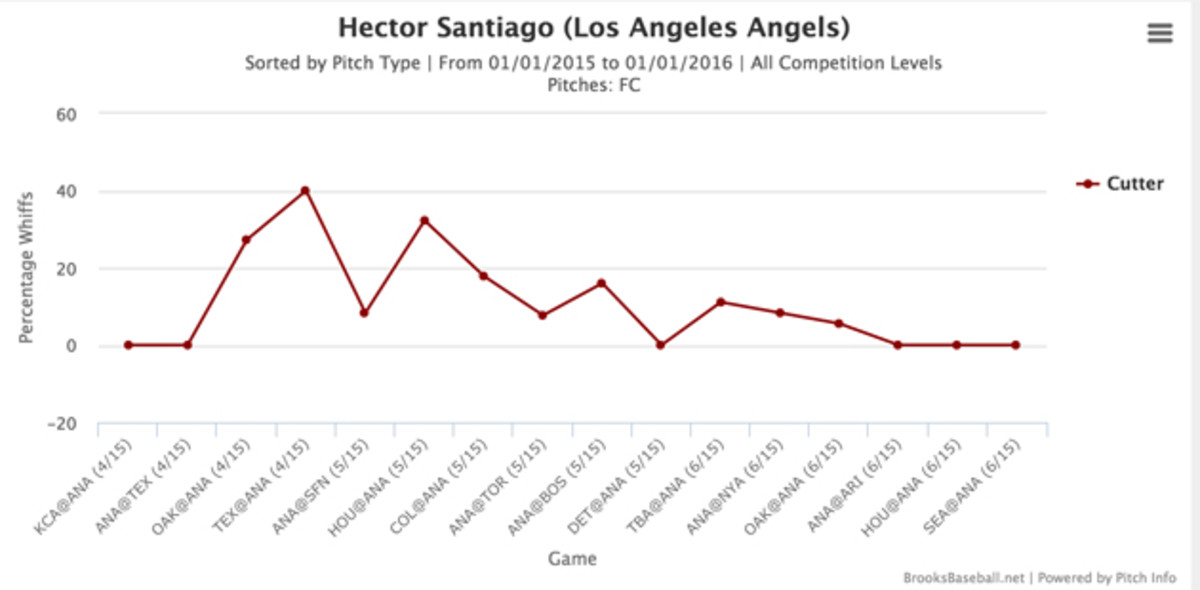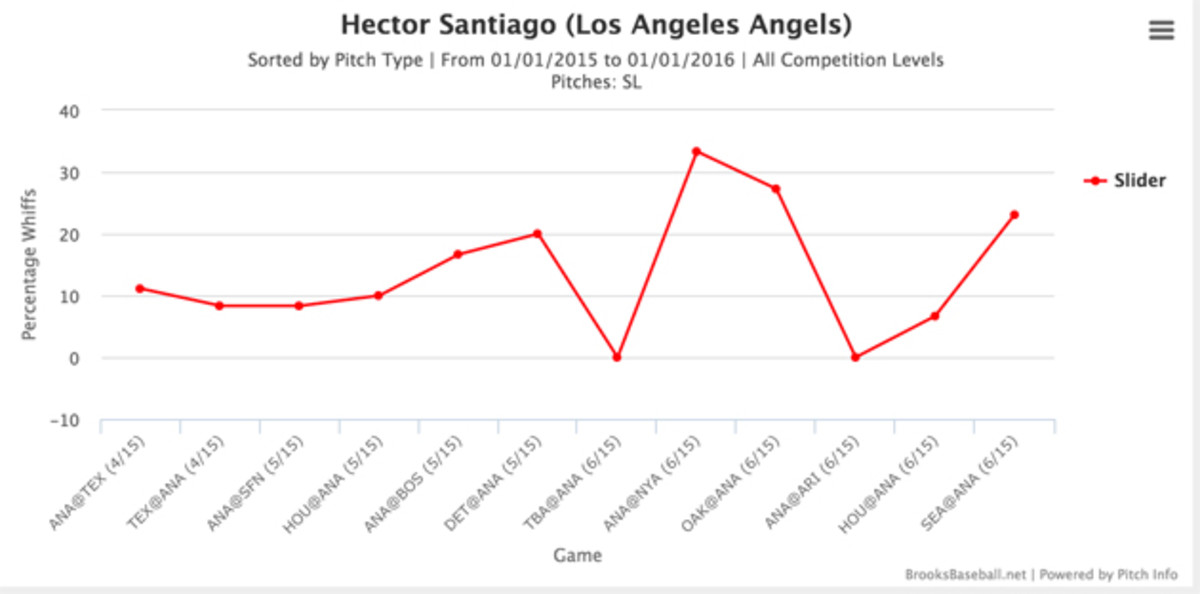Pitcher Scouting: Hector Santiago mixing breaking balls to fool hitters

Hector Santiago is in the midst of a mini-breakout season, posting a 2.58 ERA, 1.13 WHIP and 88 strikeouts in 94 1/3 innings covering 15 starts and one relief appearance. After modest success as a starter with the White Sox in 2013, he was part of the three-team deal at that year’s Winter Meetings that landed Adam Eaton in Chicago and Mark Trumbo in Arizona. He enjoyed another year of steady, yet unremarkable success with the Angels in 2014, but never hinted that he might one day emerge as a key piece in the rotation of a playoff contender.
That is exactly what Santiago has become this season. The Angels enter play on Wednesday at 41-37, four games behind the Astros in the AL West and jockeying for position with a number of teams in the Wild Card standings. Santiago leads the team in ERA, strikeout rate (22.6%) and opponents’ batting average (.212). To be fair, he has been a bit fortunate, and that’s why I’m only calling it a mini-breakout at this point. Santiago is walking too many batters (8.8% walk rate), has allowed 13 homers, sports a ground-ball rate south of 30%, and has the seventh-highest hard-hit percentage in the league (33.6%).
Hitting report: Young power hitters making a name for themselves
Before diagnosing Santiago’s ability to keep up this level of production all season, however, let’s discuss a significant change to his repertoire that he has made in 2015. According to Pitch F/X, Santiago threw his cutter 6.2% of the time in 2013 and 8.2% last year. This season, its usage rate is up to 14%. It’s not just a slider being misidentified as a cutter, either. How do we know? Well, for one, thing, Pitch F/X says he never threw a slider until this season, and he’s throwing that pitch on 6.4% of his offerings. For another, the cutter is coming in at 83.5 mph, while the slider is at 80.2 mph. They also have drastically different movement patterns, especially vertically.
Here’s visual evidence that they are, indeed, two different pitches, from a May 2 game against the Giants in which he threw 12 of each.
The cutter, to Buster Posey.
And the slider, to Joe Panik.
Santiago had decent results with the cutter through about the middle of June. Hitters had a .212 batting average and .385 slugging percentage against the pitch, and he was throwing it a little more than 16% of the time. Something interesting happened, however, during his June 17 start against the Diamondbacks. After thowing the cutter at least nine times in ever start, and throwing it at least 18 times in five of the eight starts before he took on Arizona, he offered it up just five times in the desert. That trend has continued in his two subsequent starts. Santiago threw five cutters against the Astros on June 22, and just four against the Mariners on June 28.
[daily_cut.mlb]Those last two starts also happened to be two of Santiago’s best of the season. He held the Astros to one run on two hits in six innings, striking out four and walking one. Six days later, he tossed seven innings of one-run, three-hit, six-strikeout ball in a tough-luck no-decision against the Mariners. He threw more sliders in both of those starts than he had in any previous outing this year, so it appears, in this incredibly tiny sample, that he’s starting to favor the slider as his west-to-east pitch over his cutter.
I went looking for reasons why Santiago abandoned the cutter in his last few starts, and two specific data points stood out. Here’s what happened when he threw a cutter to Josh Phegley of the A’s on June 12, one of the final cutters he offered in that game.
And this is the first cutter from his next start, the first one in which he started easing off the pitch. Paul Goldschmidt didn’t have all that much respect for it.
That’s not the end of his cutter’s increasing hittability. Here’s the pitch’s whiff rate by start this season.

Conversely, here’s Santiago’s slider whiff rate by start in 2015.

So it seems that hitters have started making the adjustment to the fact that Santiago is more willing to throw the cutter. What we’re now seeing is his adjustment to that adjustment, which is to throw more sliders. The slider, of course, has a similar shape to the cutter, but it breaks more, both horizontally and vertically, and comes in anywhere between three and six mph slower. Santiago has thrown the slider 28 times in his last two starts. He has gotten 19 strikes out of it, including four whiffs and two strikeouts, and hitters are 0-for-8 against it when they put it in play.
This is not the end of the adjustment cycle for Santiago. While he is having a nice season for the Angels and his fantasy owners, he didn’t suddenly develop into an ace between last year and this year. His stuff is not of the especially nasty variety, and that means he’s going to have to keep making changes to try to stay a step ahead of the competition in the batter’s box. If he can keep on missing bats at this rate, while getting his HR/FB ratio beneath 10%, he can sustain the level of production he has had this year. Whether or not he can actually do that is a completely different question. If I owned Santiago, I’d be trying to sell him to a pitching-needy owner in my league. Now might be the best time to cash out.
